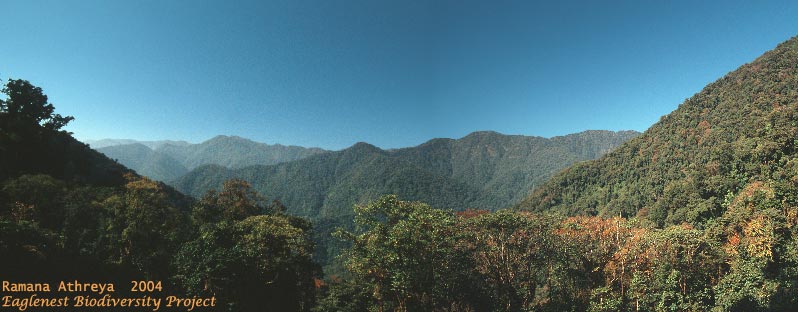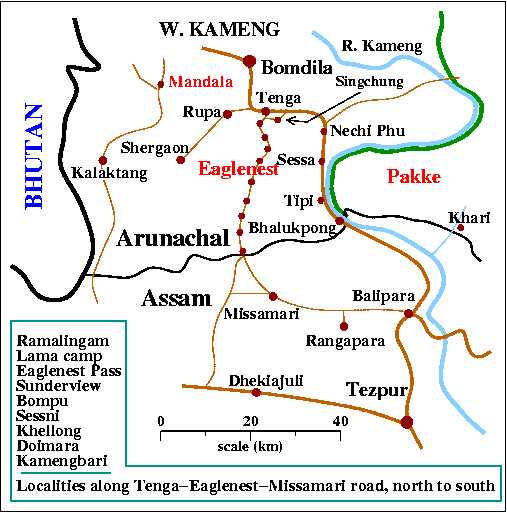|

A
panoramic montage of the sub-tropical forest clothing the western
ridges of Eaglenest. Bhutan lies beyond.
|
Western Arunachal Pradesh
Eaglenest Wildlife Sanctuary
Page content :
Birding
Areas
Boarding & Lodging
Contact
Addresses
Entry
Permits
General Information
Link to landscape images
Map
of the area
Miscellaneous
Transport
General Information
Area :
218 sq. km
Altitude :
500-3200m (accessible 100-3200m including adjacent areas; road
100-2800m)
Lat-Long :
27.1N 92.4E, in W. Kameng district, Arunachal Pradesh, India
See map
Reserve HQ : Seijusa1 (DFO),
Tenga/Singchung (Range Office)
Entry points :
Tenga from the north (recommended),
Doimara from the south.
Vegetation Type : lowland
evergreen forest (better at Pakke); broad-leaved forest, bamboo,
conifers; roadside scrub and farmland - all these in both subtropical
and temperate altitudes;
Best Season - Birds
: November-May. More birdsong in April-May but fewer
winter birds.
Best Season -
butterflies/herps : monsoon, especially May and
October.
Speciality Birds : rufous-bellied
hawk-eagle, northern goshawk, pied falconet, common hill-partridge,
temminck's tragopan, ashy wood-pigeon, tawny wood-owl, rufous-necked
hornbill, ward's trogon, golden-throated barbet, crimson-breasted
pied-woodpecker, bay woodpecker, pale-headed woodpecker, grey-chinned
minivet, rufous-bellied bulbul, maroon-backed accentor, eye-browed
thrush, fea's thrush, gould's shortwing, white-browed shortwing,
blue-fronted robin, little forkail, golden bush-robin,
rufous-breasted bush-robin, puple cochoa, grey-sided laughing-thrush,
scaly laughing-thrush, black-faced laughing-thrush, red-faced liocichla,
coral-billed scimitar-babbler, slender-billed scimitar-babbler, 6
wren-babblers (wedge-billed, bar-winged, pygmy, spotted,
rufous-throated and scaly-breasted), gold-headed babbler, cutia,
rufous-bellied shrike-babbler, green shrike-babbler, white-hooded
babbler, red-tailed minla, 6 tit-babblers/fulvettas (incl.
golden-breasted, brown-throated, and yellow-throated), 3 sibias (incl.
beautiful, and rufous-backed), 5 yuhinas (incl. black-chinned,
rufous-vented and white-naped), fire-tailed myzornis, 6
parrotbills (greater and lesser rufous-headed, brown, grey-headed and
fulvous-fronted), mountain tailorbird, 3 tesias (chestnut-headed,
grey-bellied and slaty-bellied), 8 flycatcher-warblers (incl.
broad-billed, white-spectacled, chestnut-crowned and black-faced), 4
niltavas (incl. vivid and large), 13 flycatchers (incl.
white-gorgeted), rufous-bellied and grey-crested tits, sultan tit,
beautiful nuthatch, wallcreeper, brown-throated treecreeper, yellow-bellied
flowerpecker, mrs gould's and fire-tailed sunbird, gold-naped
black-finch, beavan's bullfinch, brown bullfinch.
Birding Areas
Bhalupong-Tenga Road
: Passes along the eastern borders of the Eaglenest
and Sessa sanctuaries and provides an excellent birding transect from
300-1600m altitude, that is, apart from the traffic. The corresponding
areas inside Eaglenest are, naturally, better but this is an option for
birders who dont have the time for Eaglenest.
Northern slope
Tenga : 1200m.
Farmland and habitation.
Ramalingam : 1780m. Subtropical
farmland, scrub and degraded forest.
Lama Camp : 2350m.
Temperate broad-leaved primary and degraded forest.
Ridge : Temperate
bamboo, conifer and broad-leaved forest and scrub.
Eaglenest Pass :
2800m; Bra-Top
: 3200m; Piri-La : 3000m?
Bra-Top and Piri-La are the only 2 locations on this list
not accessible by a vehicle and can be accessed by steep trails from
Chakoo and Lama Camp. There has been much confusion involving these 2
names and Piri-La has been used to refer to both (even in Athreya &
Kartikeyan 1995, and Choudhary 2003). The trail from Chakoo is
signposted "Piri-La Trail". It climbs up to the ridge at 3100m and then
bifurcates, the right branch climbing up immediately to Bra-Top and the
left one following the ridge to Piri-La some distance away. Survey of
India topo sheets show both these places. The Chakoo - Bra-top trail is
tough but it passes through excellent birch, fir, rhododendron and
bamboo and I've seen on that trail temminck's tragopan, fulvous-fronted
parrotbills, black bear and even a red panda!
Southern Slope
Sunderview :
2465m. Temperate broad-leaved forest and roadside scrub.
Chakoo : 2405m.
Temperate broad-leaved forest, meadows in ancient clear-felled
patches.
Bompu : 1940m.
Subtropical broad-leaved forest and bamboo, large patch of open
scrub
Sessni : 1250m.
broad-leaved forest. Old jhoom patches with secondary scrub.
Khellong : 750m.
tropical forest, grazing meadows and degraded scrub.
Kamengbari - Doimara
: 100-350m. Tropical
forest, grazing meadows, shingle banks and cultivation.
The sanctuary extends from Eaglenest Pass to a little
above Khellong along the road. The entire stretch from
Lama Camp on the northern slope, up across Eaglenest Pass and down
the southern slope to Khellong is prime birding area. Doimara and
Kamengbari are also good but the corresponding areas in Pakke tiger
reserve are better. A broad jeep track runs from Tenga to Kamengbari
through Eaglenest Pass which makes for very comfortable roadside
birding. It is this combination of roadside scrub adjacent to primary
forest just 20-30m away, apart from 3200m of altitudinal range,
which makes Eaglenest a prime birding site. The large
altitudinal range and the extraordinary bird assemblage requires a
minimum of 6-10 days with a jeep and 10-14 days on foot to do
justice to it.
Boarding &
Lodging
Bomdila (Grade 2) :
District HQ, 50 km (2.5 hr) from Eaglenest.
Tenga (Grade 3) :
28 km (1.5 hr) from Eaglenest.
Singchung (Grade
3-) : A well furnished IB (6 people), 28 km (1.5 hr) from Eaglenest. CCC!
Ramalingam (Grade
5) : An FRH (4 people), 20 km (1 hour) from Eaglenest. Camping. CCC!
Lama Camp (Grade
5) : GREF sheds (8 people), 10 km (30 min) from Eaglenest. Camping.
Sunderview (Grade
5) : GREF sheds (3 people), inside Eaglenest. Camping.
Bompu (Grade 5) :
GREF sheds (12 people), inside Eaglenest. Camping.
Sessni (Grade 5) :
GREF sheds (4 people), inside the sanctuary.
Khellong (Grade 5)
: Forest Dept. sheds (6 people), 7 km (30 min) from Eaglenest.
Doimara (Grade 4)
: a village 20 km (1 hour) from Eaglenest. Unfurnished shacks can be
arranged by the Village Chief if intimated in advance. Camping.
See town grade
and accommodation
descriptions
Camp style accommodation, whether in tents or in empty
sheds, is the only option between Lama Camp and Doimara. Tented camps in
the lower reaches, at Khellong and Sessni, are not recommended because
of elephant activity; Doimara is safe because of the electric
fence around the village. Perimeter trenches have been recommended to
facilitate year-round camping in all areas. Elephants move up above
Sessni only during summer (May - October) and so are not an issue for
winter visitors.
Contact
Eaglenest Biodiversity
Project : Ramana Athreya email
More Information on the area : Ramana
Athreya email
(rathreya at ncra . tifr . res . in)
Bird Tours : Kaati Tours & Mr. Indi Glow (President,
Bugun Welfare Society)
Mr. Glow : Tenga Market, Tenga, W. Kameng,
Arunachal Pradesh, Ph 91-3782-273359
Kaati
Tours : Ph
+91-2132-245770 email (kaati_tours
at vsnl . net)
Entry Permits
Arunachal entry
permits are required for both Indians and foreigners and are
checked on entry into Arunachal at Bhalukpong. The Circle Officers at
Tenga/Singchung/Bhalukpong/Bomdila can issue fresh permits to extend the
stay (for Indians only).
Forest entry permits
are issued by the Divisional
Forest Officer, Pakke Tiger Reserve, Seijusa. E. Kameng district,
Arunachal Pradesh. Phone +91-3778-222229 (off), 222230 (res), who also
has additional charge of Eaglenest Wildlife sanctuary. The nearest
Forest Dept presence is the Range Forest Office at Singchung.
The Bugun tribe of Tenga which lost its ancient rights
over Eaglenest (along with the Sherdukpen tribe of Rupa) now charges an
entry fee of Rs. 500 per day for foreigner and Rs. 100 for Indian
visitors, which goes into the Bugun Welfare Society (and not Govt
coffers). It has been proposed to reduce this to Rs. 250 and Rs. 50
respectively and charge Rs. 1000 per day for each 4-wheel vehicle (for
both Indians and foreigners), to encourage trekking visitors and make
vehicles pay for the damage they do to the fragile mountain road. The
money collected will be used to provide local employment for patrolling
the area and maintaining the road for visitors.
Transport
Walking is permitted inside the park.
To/From Tenga : Tenga is on the
Tezpur-Bomdila-Tawang highway and connected by buses from Itanagar,
Tezpur and Guwahati (Rs. 250 from Guwahati) and by shared jeeps from
Tezpur (early morning and noon - Rs. 160 per seat). Full jeeps may also
be hired from Tezpur, Balipara or Bhalukpong (Rs. 1200-1600) which will
also facilitate birding the excellent Bhalukpong-Tenga stretch. The 135
km long drive, mostly in the hills, takes 3-5 hour.
Tenga to Eaglenest
: The options are
1. Trek all the way with porters/camp staff
2. vehicle drop-off at Eaglenest Pass or beyond and a trek
downhill with porters/camp staff. Drop-off vehicles can be rented in
Tenga for Rs. 1000-1500
3. vehicle hired for the entire visit. Vehicles are
available at Tenga and Bomdila for Rs. 1000-2000 per day plus fuel.
Inside Eaglenest
: Access on foot through the broad jeep track is possible
all through the year. Mountain bikes and motor-cycles (none available on
hire locally) may also be used all through the year. Jeep access is
usually limited to between November and April (May). The main rainy
season is from May to October but heavy rains are a permanent threat and
could cause a temporary road block (for jeeps) during any month. Snow on
the ground is a possibility above 2000m for a few weeks from mid-January
to early March.
Exit from Eaglenest
: One can
1. Trek back over the Eaglenest Pass to Tenga
2. trek downhill and catch the daily bus from Doimara (6
days a week, with occasional no-shows)
3. arrange for a jeep pick-up inside Eaglenest and exit
via Doimara or Tenga
Visiting these places by public transport will require a
travel overhead of 3-4 days ex-Guwahati and one should keep a buffer for
bus truancy. With a private vehicle the travel component will be 1-2
days. Logistical organisation will require a day at Tenga
(alternatively, have Mr. Glow to do the organisation beforehand)
. See also transport
in W. Arunachal
Miscellaneous
All arrangements in Tenga - porters, camp staff,
provisions, vehicle booking, local entry and accommodation permits etc -
are best done through Mr. Indi Glow who lives in
Tenga, is aware of the needs of tourists (especially birders) and has
been intimately associated with the Eaglenest Biodiversity Project. In
association with the EBP he is involved in the process of identifying
and training a reliable team of camp staff who understand that for
birders "breakfast at 5.30 AM" means breakfast at 5.30 AM and that many
visitors do not consider chilly a vegetable!

(top)
The Eaglenest
Biodiversity Project was
funded by a grant from the Rufford Foundation (UK) to Ramana Athreya.
The information contained herein may be freely
used, provided that these webpages and/or the report (Athreya 2005)
are appropriately cited. The images are copyright and may
not be reproduced without permission from Ramana Athreya
The
author would appreciate an email
from people, scientists and tourists alike, who found these webpages
useful. |
|